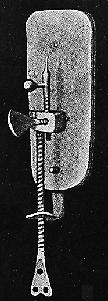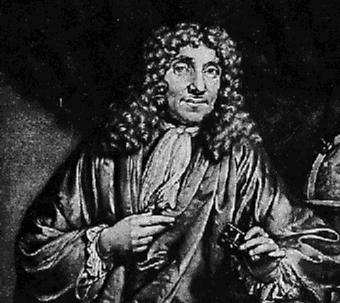Antony van Leeuwenhoek was an unlikely scientist. A tradesman of Delft,
Holland, he came from a family of tradesmen, had no fortune, received no
higher education or university degrees, and knew no languages
other than his native Dutch. This would have been enough to exclude him from
the scientific community of his time completely. Yet with skill, diligence,
an endless curiosity, and an open mind free of the scientific dogma of his day,
Leeuwenhoek succeeded in making some of the most important discoveries in
the history of biology. It was he who discovered
bacteria,
free-living and parasitic microscopic
protists,
sperm cells, blood cells, microscopic nematodes and rotifers, and much
more. His researches, which were widely circulated, opened up an entire
world of microscopic life to the awareness of scientists.
Leeuwenhoek was born in Delft on October 24, 1632. (His last name,
incidentally, often is quite troublesome to non-Dutch speakers:
"layu-wen-hook" is a passable English approximation.) His father was a
basket-maker, while his mother's family were brewers. Antony was educated as
a child in a school in the town of Warmond, then lived with his uncle at
Benthuizen; in 1648 he was apprenticed in a linen-draper's shop. Around
1654 he returned to Delft, where he spent the rest of his life. He set
himself up in business as a draper (a fabric merchant); he is also known to
have worked as a surveyor, a wine assayer, and as a minor city official.
In 1676 he served as the trustee of the estate of the deceased and
bankrupt Jan Vermeer, the famous painter, who had
had been born in the same year as Leeuwenhoek and is thought to have been a
friend of his. And at some time before 1668, Antony van Leeuwenhoek learned
to grind lenses, made simple microscopes, and began observing with them. He
seems to have been inspired to take up microscopy by having seen a copy of
Robert Hooke's illustrated book Micrographia,
which depicted Hooke's own observations with the microscope and was very
popular.
 Leeuwenhoek is known to have made over 500 "microscopes," of which fewer than
ten have survived to the present day. In basic design, probably all of
Leeuwenhoek's instruments -- certainly all the ones that are known -- were
simply powerful magnifying glasses, not compound microscopes of the type
used today.
A drawing of one of Leeuwenhoek's "microscopes" is shown at the left. Compared
to modern microscopes, it is an extremely simple device, using only one lens,
mounted in a tiny hole in the brass plate that makes up the body of the
instrument. The specimen was mounted on the sharp point that sticks up in
front of the lens, and its position and focus could be adjusted by turning
the two screws. The entire instrument was only 3-4 inches long, and had to
be held up close to the eye; it required good lighting and great patience to
use.
Leeuwenhoek is known to have made over 500 "microscopes," of which fewer than
ten have survived to the present day. In basic design, probably all of
Leeuwenhoek's instruments -- certainly all the ones that are known -- were
simply powerful magnifying glasses, not compound microscopes of the type
used today.
A drawing of one of Leeuwenhoek's "microscopes" is shown at the left. Compared
to modern microscopes, it is an extremely simple device, using only one lens,
mounted in a tiny hole in the brass plate that makes up the body of the
instrument. The specimen was mounted on the sharp point that sticks up in
front of the lens, and its position and focus could be adjusted by turning
the two screws. The entire instrument was only 3-4 inches long, and had to
be held up close to the eye; it required good lighting and great patience to
use.
Compound microscopes
(that is, microscopes using more than one lens) had been invented around
1595, nearly forty years before Leeuwenhoek was born. Several of Leeuwenhoek's
predecessors and contemporaries, notably Robert Hooke
in England and Jan Swammerdam in the Netherlands, had built
compound microscopes
and were making important discoveries
with them. These were much more similar to the microscopes in use today. Thus,
although Leeuwenhoek is sometimes called "the inventor of the microscope,"
he was no such thing.
However, because of various technical difficulties in building them, early
compound microscopes were not practical for magnifying
objects more than about twenty or thirty
times natural size. Leeuwenhoek's skill at grinding lenses, together with
his naturally acute eyesight and
great care in adjusting the lighting where he worked, enabled him to
build microscopes that magnified over 200 times, with clearer and brighter
images than any of his colleagues could achieve. What further
distinguished him was his curiosity to observe almost anything that could
be placed under his lenses, and his care in describing what he saw. Although
he himself could not draw well, he hired an illustrator to prepare drawings
of the things he saw, to accompany his written descriptions. Most of
his descriptions of microorganisms are instantly recognizable.
In 1673, Leeuwenhoek began writing letters to the newly-formed Royal Society
of London, describing what he had seen with his microscopes -- his first
letter contained some observations on the stings of bees.
For the next fifty years he corresponded with the Royal Society;
his letters, written in Dutch, were translated into English or Latin and
printed in the Philosophical Transactions of the Royal Society, and
often reprinted separately. To give some of the flavor of his discoveries,
we present extracts from his observations, together with modern pictures of
the organisms that Leeuwenhoek saw.
 In a letter of September 7, 1674, Leeuwenhoek described observations on
lake water, including an excellent description of the
green
charophyte alga Spirogyra:
"Passing just lately over this lake, . . . and examining this water next
day, I found floating therein divers earthy particles, and some green
streaks, spirally wound serpent-wise, and orderly arranged, after the manner
of the copper or tin worms, which distillers use to cool their liquors as they
distil over. The whole circumference of each of these streaks was about the
thickness of a hair of one's head. . . all consisted of very small green
globules joined together: and there were very many small green globules as
well."
In a letter of September 7, 1674, Leeuwenhoek described observations on
lake water, including an excellent description of the
green
charophyte alga Spirogyra:
"Passing just lately over this lake, . . . and examining this water next
day, I found floating therein divers earthy particles, and some green
streaks, spirally wound serpent-wise, and orderly arranged, after the manner
of the copper or tin worms, which distillers use to cool their liquors as they
distil over. The whole circumference of each of these streaks was about the
thickness of a hair of one's head. . . all consisted of very small green
globules joined together: and there were very many small green globules as
well."
 A letter dated December 25, 1702, gives descriptions of many protists, including
this ciliate, Vorticella:
"In structure these little animals were fashioned like a bell, and at the
round opening they made such a stir, that the particles in the water
thereabout were set in motion thereby. . . And though I must have seen quite
20 of these little animals on their long tails alongside one another very
gently moving, with outstretched bodies and straightened-out tails; yet in
an instant, as it were, they pulled their bodies and their tails together,
and no sooner had they contracted their bodies and tails, than they began to
stick their tails out again very leisurely, and stayed thus some time
continuing their gentle motion: which sight I found mightily diverting."
A letter dated December 25, 1702, gives descriptions of many protists, including
this ciliate, Vorticella:
"In structure these little animals were fashioned like a bell, and at the
round opening they made such a stir, that the particles in the water
thereabout were set in motion thereby. . . And though I must have seen quite
20 of these little animals on their long tails alongside one another very
gently moving, with outstretched bodies and straightened-out tails; yet in
an instant, as it were, they pulled their bodies and their tails together,
and no sooner had they contracted their bodies and tails, than they began to
stick their tails out again very leisurely, and stayed thus some time
continuing their gentle motion: which sight I found mightily diverting."
On September 17, 1683, Leeuwenhoek wrote to the Royal Society about his
observations on the plaque between his own teeth, "a little white matter,
which is as thick as if 'twere batter." He repeated these observations on
two ladies (probably his own wife and daughter), and on two old men who had
never cleaned their teeth in their lives. Looking at these samples with his
microscope, Leeuwenhoek reported how in his own mouth:
"I then most always saw, with great wonder, that in the said matter there were
many very little living animalcules, very prettily a-moving. The biggest
sort. . . had a very strong and swift motion, and shot through the water (or
spittle) like a pike does through the water. The second sort. . . oft-times
spun round like a top. . . and these were far more in number." In the mouth
of one of the old men, Leeuwenhoek found "an unbelievably great company of
living animalcules, a-swimming more nimbly than any I had ever seen up to
this time. The biggest sort. . . bent their body into curves in going
forwards. . . Moreover, the other animalcules were in such enormous
numbers, that all the water. . . seemed to be alive." These were among the
first observations on living
bacteria ever recorded.
Leeuwenhoek looked at animal and plant tissues, at mineral crystals and
at fossils. He was the first to see microscopic
foraminifera,
which he described as "little cockles. . . no bigger than a coarse
sand-grain." He discovered blood cells, and was the first to see living
sperm cells of animals. He discovered microscopic animals such as
nematodes and rotifers.
The list of his discoveries goes on and on.
Leeuwenhoek soon became famous as his letters were published and translated.
In 1680 he was elected a full member of the Royal Society, joining
Robert Hooke, Henry Oldenburg, Robert Boyle,
Christopher Wren, and other scientific luminaries of his day -- although he
never attended a meeting.
In 1698 he demonstrated circulation in the capillaries of an eel to Tsar Peter
the Great of Russia, and he continued to receive visitors curious to see
the strange things he was describing. He continued his observations until
the last days of his life. After his death on August 30, 1723, the pastor of
the New Church at Delft wrote to the Royal Society:
. . . Antony van Leeuwenhoek considered that what is true in natural
philosophy can be most fruitfully investigated by the experimental method,
supported by the evidence of the senses; for which reason, by diligence and
tireless labour he made with his own hand certain most excellent lenses, with
the aid of which he discovered many secrets of Nature, now famous throughout
the whole philosophical World.
British scientist Brian J. Ford has rediscovered some of Leeuwenhoek's
original specimens in the archives of the Royal Society of London. His study of
these historic specimens and other material, using Leeuwenhoek's own microscopes
and other single-lens microscopes, has shown how remarkably good a scientist and
craftsman Leeuwenhoek really was. 






